Calories 2 Tsp Chopped Beef Liver
Healthy Beef Liver Recipe & Nutrition Facts

If the thought of eating liver is sending shivers down your spine due to how it was prepared by your mother (overcooked similar to rubber, tasteless, and served alongside a pile of mashed potato drowned in gravy), I am here to encourage you that liver doesn't have to end up like that anymore.
You are most likely aware of the profound nutrient density that liver contains. It blows past all the so-called superfoods, and kale. It is the sacred part of the animal that serves a purpose in supplying us with the biggest bang for buck, gram for gram.
In this article we will cover:
-
Beef Liver Nutrition
-
Where to Buy Beef Liver
-
Is Beef Liver Good For You?
-
How To Cook Beef Liver
Beef Liver Nutrition
Liver, especially the beef one, is a tremendous and superior source of nutrients needed to run our complex metabolic machinery. Not only animal-sourced foods trump the majority of plant foods with their abundance but also the spectrum of nutrients.
Unfortunately, relying on plants as a sole food is a poor and illogical way of supplying your body with the raw ingredients it needs to invest in your health. The absorption is one of the most factors when considering the rate-limiting effects of focussing on a plant-based or vegan-orientated diet. In addition to the ridiculous amount of financial strain buying plants, there's time commitment in cooking or dehydrating them and trying to consume them in sufficient quantities.
I am not invalidating plants by any means. However, regarding nutrient density, nothing cuts it compared to shellfish and organ meats such as liver.
Beef liver is a true powerhouse, who needs to take a multivitamin when you have it with real food in its true methylated and superior absorbable forms compared to synthetic supplements which have shown differences in effect in human studies.
My friend Siim Land with a great quote below and also co-author of the book "The Mineral Fix" with Dr.James DiNicolantonio.
What Is Special About Beef Liver?
We have high values in all the B vitamins (B1, B2, B3, B5, B6, B7, B9, B12), we have the true form vitamin A, retinol. in addition, we have copper, iron, choline, vitamin K2, manganese, selenium, zinc, and even magnesium. The remaining nutrients are in smaller amounts but still hold value even vitamin C surprisingly is found in liver. Thus, liver (100 grams per day) can cover up to 50% of the recommended daily allowance (RDA) for iron, zinc, selenium, vitamins B12, B1, B2, B6, and 100% of vitamin A.
Vitamin B9, folate derived from liver also has high aggregate bioavailability (approximately 80%), same as that from vegetables and fruit.
Vitamin A, primarily speaking retinol is the true vitamin A, which is a more useable form. It requires no conversion which the previtamin A, betacarotene forms require. This is further complicated when we understand the great variation between the gene, BCO1 which does this conversion which around 40% of the population has, especially seen in northern Europeans. Adding further issues to the beta carotene monooxygenase requires copper as a cofactor. This is where the magic of liver comes in supplying both the readily available vitamin A but also the abundant copper needed to help regulate iron metabolism, make dopamine and noradrenaline, collagen synthesis, and much more.
Low vitamin A is associated with a number of immune system issues and mucosal barrier dysfunction which is seen with secretory IgA responses and production. Also, epithelial cell complications with keratosis pilaris, psoriasis, and acne all have been correlated to vitamin A deficiency.
Well, being a liver, it is technically a very metabolically active organ, where the first-pass effect allows the first dibs on nutrients being digested or made in the colons of animals. As a by-product of that, first dibs action, the liver stores and utilizes critical vitamins and minerals to allow it to function optimally.
When the animal enjoyed a pleasant life of socializing with space, eating grass, moving up and down hills and farting about, not being tortured with antibiotics and hormones, and being kissed by the sun on its backside to sulfate its hormones, and rained on occasionally, then we can expect a superior amount of nutrients compared to a cow that's raised in a factory not seeing the light of day, had little movement and fed cheap noncompatible food for its digestion then problems arise.
I created the below image which does a great job in showcasing the health benefits of liver. This data is using raw values. We should also consider the way we cook liver which can also influence the final product or nutritional value. When we slow cook, steam or sous-vide, we have a greater capacity to retain the valuable nutrients.

Nutrient Density Comparison Of Plant Versus Animal Foods
Additionally, comparing liver to other so-called superfoods and animal products, we can see how nutrient-dense it really is.
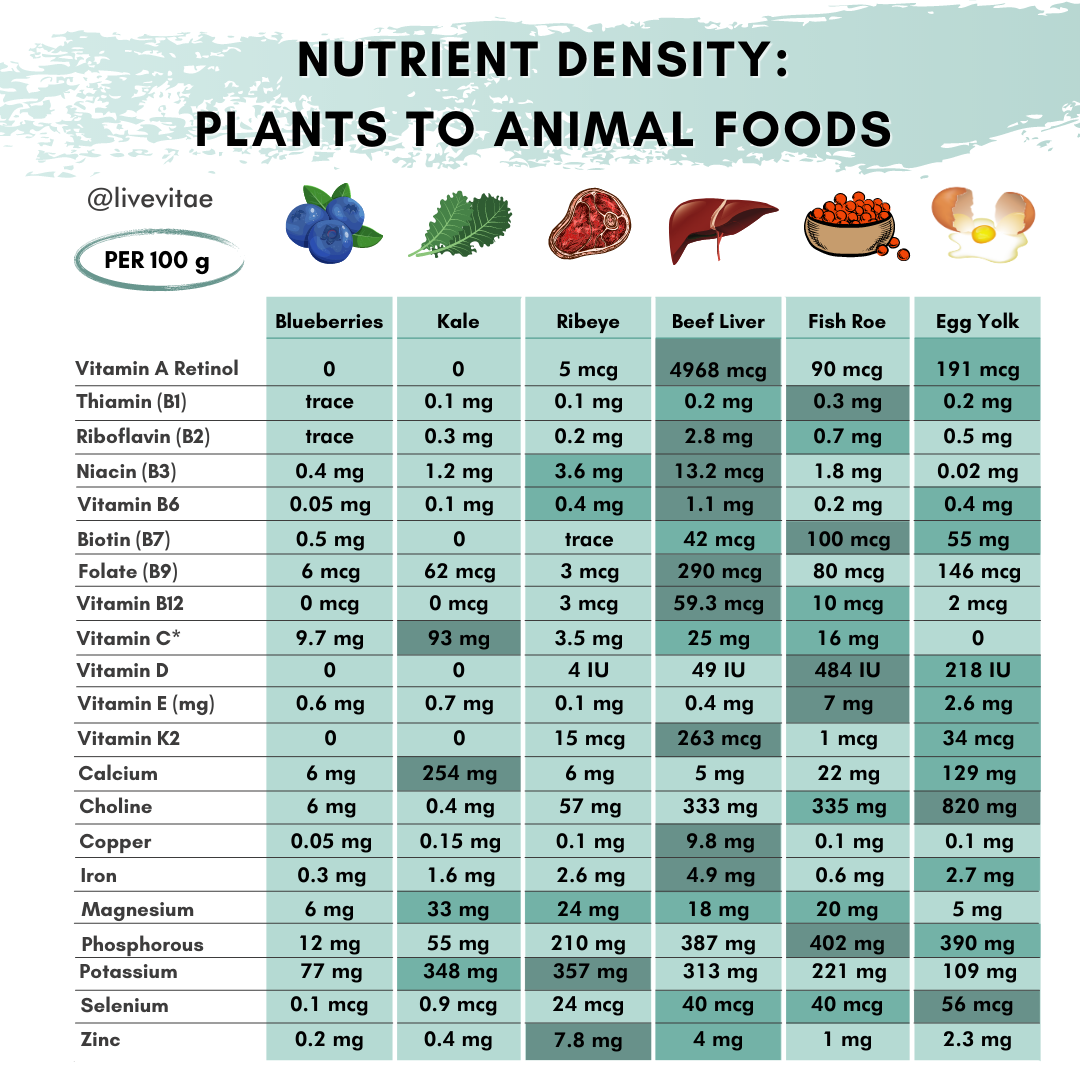
Liver Nutrition Comparison
What is the actual difference between beef, calves, chicken, duck, lamb, and pork? Nutritionally speaking there are some small variables as you can see in the image below.
There is definitely a taste difference between them, which is slightly more personal. I am not a fan of pork liver. I prefer calves for their lighter taste, duck for richness, and beef purely biggest it's a nutrient powerhouse. A little bit goes a long way.
The data/statistics used for the graphics are based on Nutritionaldta. self and Cronometer. All composed in their raw value, and typically from conventional sources too. As you will know later on there are more benefits in grass-fed meat and organs than conventional farming.

Where to Buy Beef Liver?
The liver is not specifically a site of toxins as many are led to believe. When we think of xenobiotics and metabolic waste by-products, the liver is the last place an organism wants to store it.
We see this in blood chemistry tests with reactive proteins being elevated in response to inflammation (includes cytokines, infections, endotoxins, stress, etc). It does not mean the liver is pilling up and storing heavy metals, nano plastics, and synthetic hormones.
This would more likely be excreted out of the liver, circulated in the bloodstream, and transported in adipose tissue to deal with. This is the very issue when consuming fattier meats from corn-fed or conventional treated farming practices. We consume this fatty meat or the fattier intramuscular fat and we are consuming the xenobiotics as a by-product. No, thank you.
That's why it is a must to buy high-quality, grass-fed, and finished beef. I personally get my liver when living in London, from farmer's markets (ordering it in advance to make sure they don't sell out is a good tip) or additionally from reputable brands which sell beef organs and other animals.
There are some supermarkets that do sell organ meats such as liver. But unless it is grass-fed or pasture-raised chicken, I'll avoid it due to the nature and risk of the animal having a sedentary, inflammatory lifestyle which can lead to metabolic dysfunction / non-alcoholic fatty liver disease and then predispose that animal to store toxins in organs such as the liver, kidneys, and brain, etc.

Is Beef Liver Good For You?
As mentioned above, beef liver provides the essential raw ingredients we need to build complex life. Be with DNA bases or methylation needs and co-factors for transporting and producing red blood cells from bone marrow and neurotransmitter to think, adapt to stress, sleep, and much more.
The health benefits of beef liver were also researched by 3 scientists who actually won a Nobel Prize in Physiology or Medicine 1934 for curing anemia.
The Caroline Institute has awarded this year's prize for Physiology or Medicine to three American investigators, viz. Professor George Minot, of the Harvard Medical School (Boston), Dr. William Murphy, of the same College, and Professor George Whipple, of the School of Medicine (Rochester, New York), in recognition of their discoveries respecting liver therapy in anaemias.
Professor Whipple researched the influence of food and its effect on blood regeneration. He quickly discovered from using dogs in his experiments that certain kinds of food were considerably superior to others which gave stimulus to a more vigorous reformation of blood, stimulated the bone marrow where red blood cell formation begins.
It was first and foremost liver, then kidney, then meat, and next after that certain vegetable articles of food too, e.g. apricots, that proved in an especial degree to have a strong stimulating effect.
Whipple's investigations had the strongest stimulating effect upon the bone marrow's erythropoietic, red-corpuscle forming function. Consumption of the liver diet in treatment was in the range of 100-600 grams of liver per day. A fairly large amount.
It was found, however, that, on the diet being put contemporaneously to the test at a large number of hospitals in the United States, results were actually obtained from the treatment that were astonishing, showing a more rapid improvement and blood formation, i.e. a more complete restoration to normal conditions, than had been seen to result from any other methods of treatment.
The success with interventions in America grew and began replicating with great success around the world curing (which is not often said lightly by the way) pernicious anemia.
Modern medicine and science have not extracted the very health-promoting substance and is now given to patients suffering as the original intervention was fairly not tolerable given the large quantities each day needed to maintain free of health issues.
Whipple's investigations have taught us that, next to liver and kidney, meat is the article of our regimen that exercises the greatest influence as a stimulus to the blood regeneration carried on by the bone marrow.
We should be aware that whilst the liver is a rich source of nutrients for humans. We can go overboard. Humans did not primarily just eat organs or hundreds of grams of liver per day. We ate the muscles, the cartilage, bone marrow and also consumed them with seasonal plants when abundant. Wild animals can present with more nutrients and contain heavy metals that need to be considered. Take caution with not going to go crazy with the consumption of the liver. As shown in the graphics on this article we only need to consume a small amount to get the benefits. In fact, it might be a greater strategy to have more frequent and smaller servings of the liver. That way we do not over-saturate the nutrient transporters of our cells. Use common sense.
If you want to boost your brain health with a B-like vitamin called choline then liver is your best option. It is extremely important in brain development, especially in pregnancy, which utilizes our reserves of many nutrients, particularly choline. Yes, that's right, you need choline when your pregnant quite the opposite of what is said. If you are not able to consume a lot of eggs then liver is the answer to be part of a well-rounded healthy diet.
Finally, it would be extremely important as we age to ensure our nutrient needs are met. For the elderly, due to lower stomach acid, impaired digestive function, and unfavorable decline in metabolism, their needs would need to meet. This is shown in research in elderly populations having nutrient shortfalls with amino acids, B12, iron, zinc, calcium, folate, and possibly more. Simply, opting for liver once or twice per week would be a genius intervention.

How To Prepare Beef Liver
Fussy eaters such as infants would be pleased to know that you can ground up the liver in a way to make it not smell and taste like liver resulting in a ground beef meat and liver combination. In self subjective questionnaires in studies, it was palatable in powdered form. In reality, grounding is the most applicable thing. Simply asking your butcher to do this would be a great idea.
My preferred choice when it comes to preparing liver is making sure the butcher slices the liver thinly as possible and the inedible parts were removed. This makes cooking hassle-free and gives you a cleaner taste with the finished product.
Different animal livers taste differently. My preference has changed and can actually vary depending on how well it is prepared. I now enjoy more beef liver but only when it is finely sliced.
I do not consume raw liver, although I have seen many people go this route. Dicing the liver up into small cubes or capsule-like shapes, then freezing the liver pieces for up to a month to kill possible microorganisms then consuming.
My preferred way of cooking beef liver is simply using a pan or hot plate greased with ghee and then pan-frying the liver until just cooked through the middle, somewhat blushing, and taken some golden color on the outside without burning or charring.
Depending on the size and shape of the raw liver you might need to adjust accordingly to fit your pan. I have previously tried slicing prior to cooking but the liver cooks too quickly and results in a poor end product.
The steaming or sous viding route does not interest me. The minor nutrient reductions (summarised below) with grilling or sauteeing is acceptable and fine in my book to allow for a more enhanced and pleasant experience.
"Consumption of the processed liver should be encouraged, especially due to common folate deficiency and controversy surrounding excess synthetic folic acid consumption. Additionally, in terms of food preparation, sous-vide (60 °C/75 min), steaming and grilling can be recommended for liver preparation in households or food services as an ideal way to maintain maximum folate retention."
In summary of the study above using chicken liver, grilling is still a preferred way of utilizing the nutritional benefits such as folate retention.
If you are adding liver into your diet, any way is a benefit just try not to overcook it which will devalue and make an unpleasant experience similar to how I described it in the beginning.
One final cooking tip is to ensure you take the liver out of the fridge and allow it to cool down, achieving room temperature. This allows the meat to be fully cooked through and not have an extremely raw or rare strip down the middle of the piece. The same applies more so to meat which is much thicker than the liver.
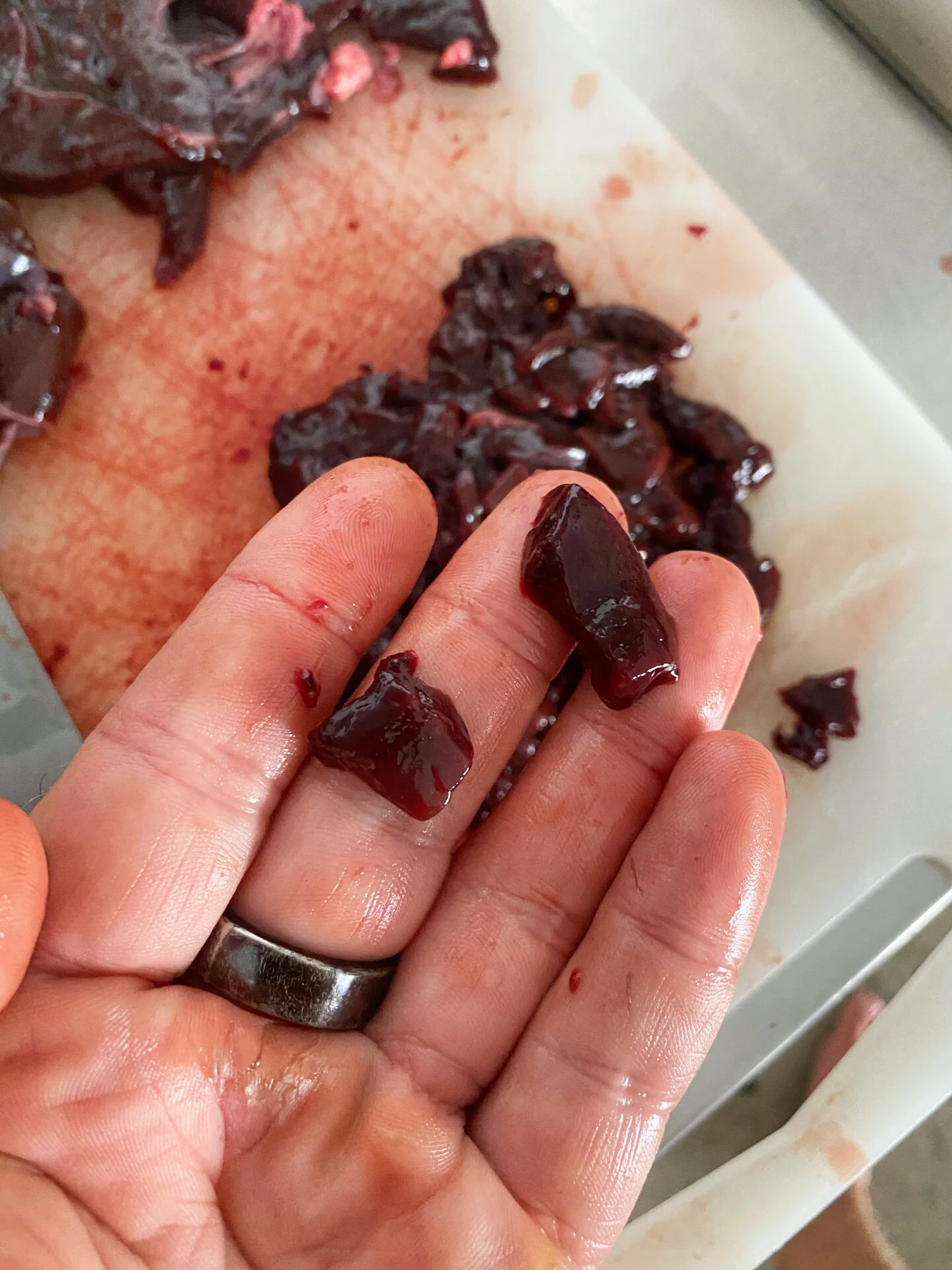
Grass-Fed Beef Liver
It goes without surprise that the natural and ancestral diet of cows is grass and not grain, corn nor soy. This difference between diet also reflects the end product's nutritional components.
There is a superior difference not massively but present in grass-fed meat in particular with minerals, fatty acid, vitamin E content, beta carotene, and essential fatty acids such as omega 3. This is not something amazing but it holds value in addition to the regenerative nature that goes into grass-fed agriculture. You are not only investing in your body with superior amino acids and minerals but also into the environment, the farmers competing with the cheap mass-produced inferior tasting beef.
You will definitely taste the difference in grass-fed organ meats compared to conventionally produced meat. There is also a light and day difference in appearance which chicken liver from the supermarket shows.
You don't need to invest in wagyu beef especially not the liver. Wagyu beef to me is fake health food. By no means is a cow designed to consume copious amounts of hops, be stationary, and then get massaged. This is reflected in different nutritional values in a wagyu liver compared to a crossbred wagyu liver. There was 36.9% more amino acid content, greater amounts of carnitine, glutathione and minerals such as iron, zinc, and selenium.
It should be noted that there are additional benefits of consuming grass-fed animals that have had a superior lifestyle and diet. One would be void of environmental pollutants such as heavy metals.
Another reason to include liver in the diet is that recent results show porcine as well as bovine liver to be almost free of harmful substances like heavy metals (a former reason to avoid the uptake of liver) which are far below the allowed threshold or even below the technical detection limit.
The quote above and conclusion from the research paper below, states that avoidance of meat especially the liver in a well-balanced diet increases the likelihood of metabolic syndrome and cancers.
Any kind of an unbalanced diet, either avoiding meat or fruit or vegetables more or less leads to (micro-) nutrient deficiencies and consecutive disorders or diseases like metabolic syndrome and cancer, especially in groups with higher needs (pregnant or lactating women, excessive exercise, growing children, elderly, etc.). At this time one has to assume, that a mixed and balanced diet with higher amounts of fruits and vegetables and moderate amounts of meat including liver, paired with body exercise is recommended and seems to be the best recipe for nutritional support for the prevention of deficiencies and physiological malfunctions.
There has been a lot of noise and previous recommendations to avoid liver consumption that has been overturned by recent studies showing bovine liver to be almost free of substances of very high concern such as heavy metals.
The final benefit of opting for grass-fed organs is that it is cheap. The organs are still relatively cheap compared to the prime cuts such as ribeye, sirloin, and fillet. That way you can prioritize opting for grass-fed liver and other organs and if needed, stick to leaner cuts such as ground beef when you need to be more diligent with your shopping budget.
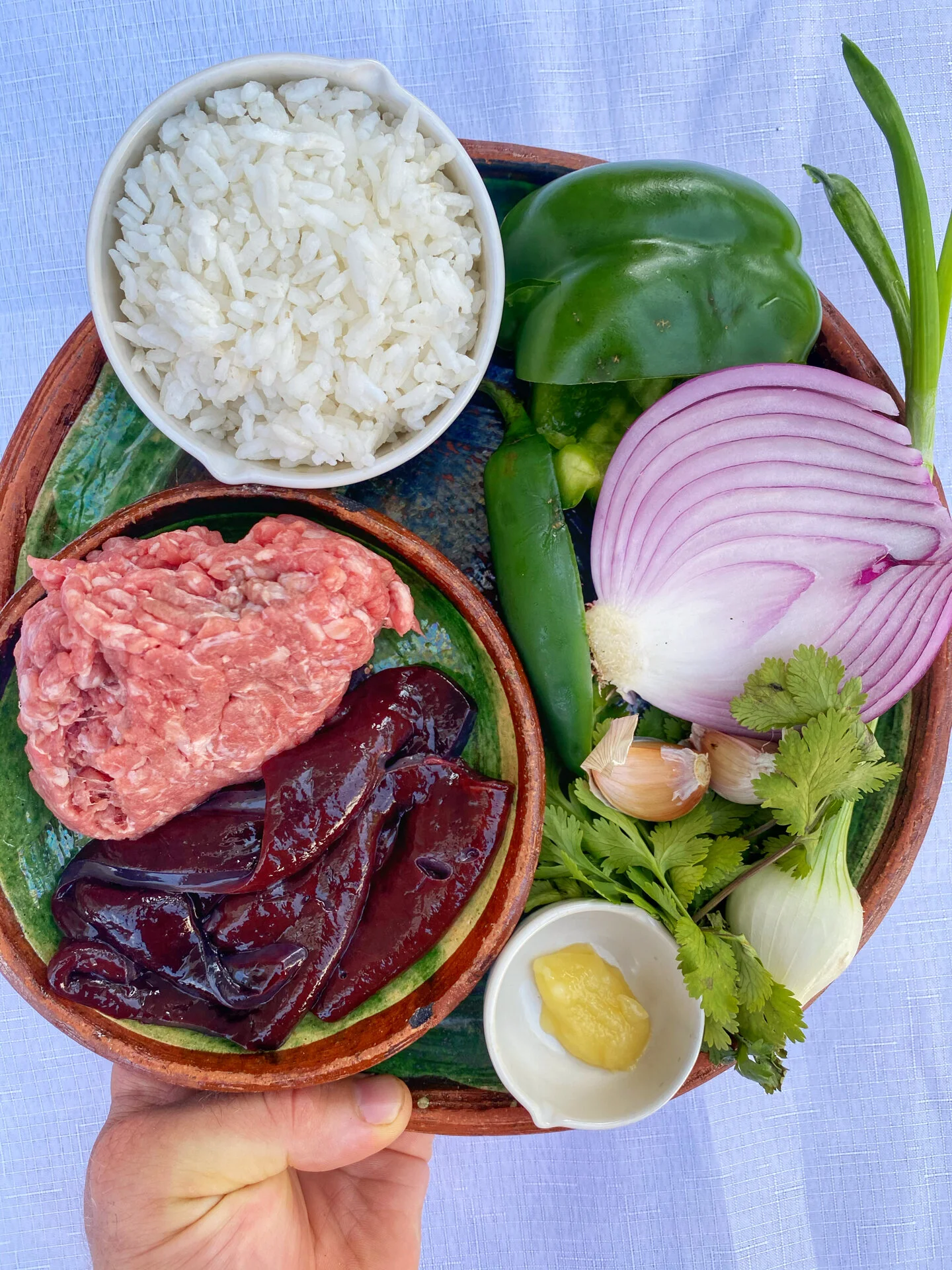
How To Cook Beef Liver
My preferred way of cooking beef liver is simply pan-fried or sauteed in a hot pan slightly greased with ghee or tallow. Other options include using the grill (or broiler) or griddle pan. I suppose you could roast it but you will miss out on the mallard reaction which forms a slight crust or glycation of the proteins on the exterior. additionally, in the recipe below, I decided to dice up the liver into small 1cm cubes to mix and incorporate with ground beef. it was a great idea and the results are below.
The griddle and grill (broil) might be too harsh compared to using a pan that is more controlled and functional with cooking. Especially with something as delicate as organ meats like the beef liver.
It only takes a few minutes to cook beef liver. This depends on the thickness of the liver slices. The thicker they are the more time it takes to cook. The thinner the beef liver slices are the quicker it takes and you can flash fry them in 1-2 minutes per side.
i do not subscribe to the old-fashioned belief of needing to soak your livers in milk to tenderize it. I have never noticed much difference or benefit from doing so. For me it just further complicates it and puts further barriers and steps to take you off consuming one of the most nutrient dense foods on our planet. Simply, source quality organs, prep it accordingly, or ask your butcher and then cook it in the easiest way and incorporate into a meal which tastes magical like below.
Of course, the first few times you cook live it might not turn out as expected. But this is the wonders of practicing, you progress and can do better next time.
My beef liver recipe below is a great way of mixing and incorporating liver and organs into your diet.

Beef Liver Recipe
I thought of this beef liver recipe when cycling back from managing to source grass-fed beef in Huatulco, Oaxaca, Mexico recently from a local butcher. The recipe is a bowl of color and flavors. Gone are the days when the liver looking dull and grey. We can jazz it up compliment it with herbs, plants, and spices.
This recipe is great for anyone who wants to dip their toes in with consuming liver. You can adjust the ratios of ground meat to liver or you can just go all-in with beef liver. The choice is yours.
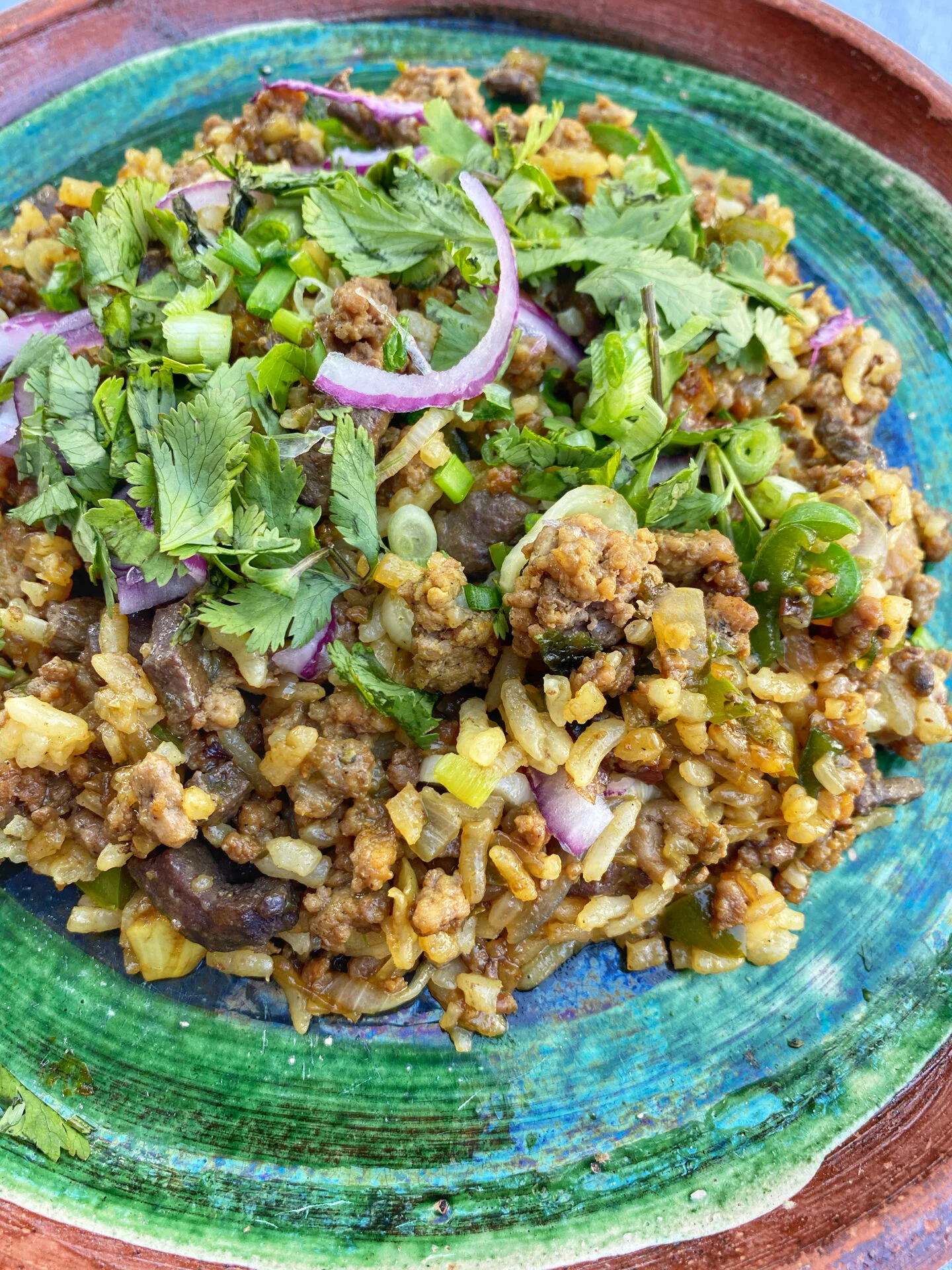
GROUND BEEF AND BEEF LIVER STIR FRY
Serves: 2 to 3
Prep time: 10 minutes
Cooking time: 15 minutes
Skill level: Easy to medium
Beef Liver Ingredients
-
300 grams ground beef
-
200 grams beef liver (thinly sliced & diced into 1cm cubes)
-
1 tsp ghee
-
1 cup pre-cooked white basmati rice (check my free ebook for the recipe)
-
1/2 red onion (finely diced or sliced) - Reserving a little for the end.
-
1/2 green bell pepper (deseeded, core removed, and sliced lengthways)
-
2 garlic cloves (finely diced)
-
A small handful of coriander (cilantro)
-
1 spring onion (scallion) (finely sliced)
-
2 tsp coconut aminos
-
2 tsp raw honey
-
1/2 tbsp dried oregano
-
1/2 tsp turmeric powder
-
1/4 tsp black pepper
-
1/2 lime
-
Celtic sea salt to taste
Beef Liver Instructions
-
Prepare all ingredients so that you are ready to go.
-
In a wide saucepan, heat on medium-high heat. Add the ghee.
-
Add the diced red onion and cook down until soft and transparent.
-
Add the green bell pepper cook for 1-2 minutes.
-
Add the ground beef, spread out but do not break up until it gets some color. Around 2 minutes later, break up and flip over to the other side of the ground beef.
-
At this time, add the garlic cloves, oregano, turmeric, and black pepper. Cook for 30 seconds.
-
Make space for the liver in the middle of the pan, so spread out the food to the exterior. Add the diced liver now to the vacant space in the middle.
-
Cook for 2 minutes, and move the liver around so it gets evenly cooked.
-
Add the precooked rice to the pan.
-
Mix everything together.
-
Reduce the heat down. Add the coconut aminos, raw honey, squeeze 1/2 of the lime, and season to taste.
-
Remove from the heat and plate up.
-
Serve on plates and sprinkle the reserved red onion slices, coriander leaves, and spring onion on top.
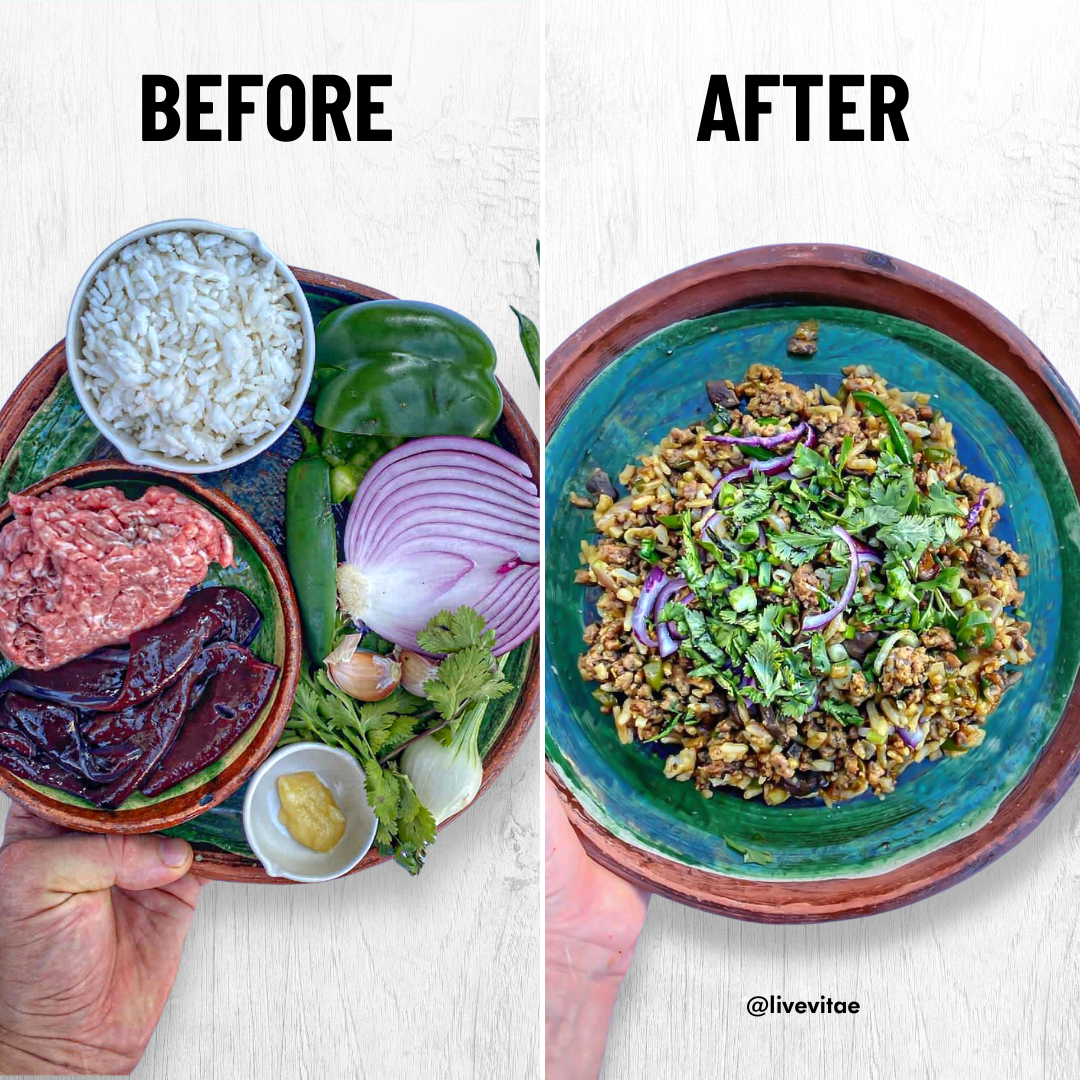
Nutrition facts per serving (based on 2 servings)
Calories: 496
Protein: 63.2
Carbs: 35
Fat: 18.6
Fibre: 1.7
Vitamin B1: 0.3mg
Vitamin B2: 3mg
Vitamin B3: 21.8mg
Vitamin B5: 8.5mg
Vitamin B6: 1.8mg
Vitamin B9: 310ug
Vitamin B12: 63ug
Choline: 470.5mg
Vitamin A: 17091.9IU
Retinol: 4970ug
Vitamin C: 28.7 mg
Vitamin D: 52IU
Vitamin E: 1mg
Vitamin K: 10ug
Calcium: 35mg
Copper: 10mg
Iron: 9mg
Magnesium: 60mg
Manganese: 1mg
Potassium: 900mg
Selenium: 70ug
Zinc: 15mg
Omega 3: 0g
Omega 6: 0.7g
References
Borel, P. and Desmarchelier, C., 2017. Genetic Variations Associated with Vitamin A Status and Vitamin A Bioavailability.Nutrients, 9(3), p.246.
Czarnowska-Kujawska, M., Draszanowska, A. and Gujska, E., 2020. Effect of Different Cooking Methods on Folate Content in Chicken Liver.Foods, 9(10), p.1431.
Duizer, L., Diana, A., Rathomi, H., Luftimas, D., Rahmannia, S., Santi, W., Nugraha, G., Haszard, J., Gibson, R. and Houghton, L., 2017. An Acceptability Trial of Desiccated Beef Liver and Meat Powder as Potential Fortifiers of Complementary Diets of Young Children in Indonesia.Journal of Food Science, 82(9), pp.2206-2212.
Fan, X., Liu, S., Liu, G., Zhao, J., Jiao, H., Wang, X., Song, Z. and Lin, H., 2015. Vitamin A Deficiency Impairs Mucin Expression and Suppresses the Mucosal Immune Function of the Respiratory Tract in Chicks.PLOS ONE, 10(9), p.e0139131.
Gangopadhyay, N., Moldoveanu, Z. and Stephensen, C., 1996. Vitamin A Deficiency Has Different Effects on Immunoglobulin A Production and Transport During Influenza A Infection in BALB/c Mice.The Journal of Nutrition, 126(12), pp.2960-2967.
Gruber, R., Sugarman, J., Crumrine, D., Hupe, M., Mauro, T., Mauldin, E., Thyssen, J., Brandner, J., Hennies, H., Schmuth, M. and Elias, P., 2015. Sebaceous Gland, Hair Shaft, and Epidermal Barrier Abnormalities in Keratosis Pilaris with and without Filaggrin Deficiency.The American Journal of Pathology, 185(4), pp.1012-1021.
Huang, Z., Liu, Y., Qi, G., Brand, D. and Zheng, S., 2018. Role of Vitamin A in the Immune System.Journal of Clinical Medicine, 7(9), p.258.
Kicińska, A., Glichowska, P. and Mamak, M., 2019. Micro- and macroelement contents in the liver of farm and wild animals and the health risks involved in liver consumption.Environmental Monitoring and Assessment, 191(3).
Li, R., Yu, Q., Han, L. and Cao, H., 2014. Nutritional Characteristics and Active Components in Liver from Wagyu×Qinchuan Cattle.Korean Journal for Food Science of Animal Resources, 34(2), pp.214-220.
Nikawa, T., Odahara, K., Koizumi, H., Kido, Y., Teshima, S., Rokutan, K. and Kishi, K., 1999. Vitamin A Prevents the Decline in Immunoglobulin A and Th2 Cytokine Levels in Small Intestinal Mucosa of Protein-Malnourished Mice.The Journal of Nutrition, 129(5), pp.934-941.
Nohr, D. and Biesalski, H., 2007. 'Mealthy' food: meat as a healthy and valuable source of micronutrients.Animal, 1(2), pp.309-316.
Nutrition Data, 2018. [online] Available at: <https://nutritiondata.self.com/facts/beef-products/3468/2> [Accessed 22 April 2021].
Park, K., 2015. Role of Micronutrients in Skin Health and Function.Biomolecules & Therapeutics, 23(3), pp.207-217.
The Nobel Foundation 1934, 1965.The Nobel Prize in Physiology or Medicine 1934. [online] NobelPrize.org. Available at: <https://www.nobelprize.org/prizes/medicine/1934/ceremony-speech/> [Accessed 22 April 2021].
Zeisel, S., 2004. Nutritional Importance of Choline for Brain Development.Journal of the American College of Nutrition, 23(sup6), pp.621S-626S.
Source: https://www.livevitae.com/learn/beef-liver-nutrition-and-recipe
0 Response to "Calories 2 Tsp Chopped Beef Liver"
Post a Comment